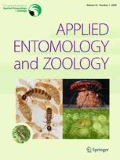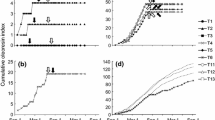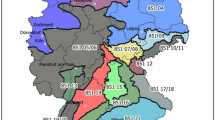Abstract
Bursaphelenchus xylophilus (Steiner et Buhrer) Nickle causes pine wilt disease and is transmitted by Monochamus alternatus Hope adults in Japan. To determine the effects of the beetle larvae on the nematode population and the effects of the nematode population on beetle larval growth, we inoculated fresh pine bolts with various combinations of B. xylophilus, M. alternatus, and the blue-stain fungus Ophiostoma minus (Hedgc.) Syd. & P. Syd., the food of the nematodes. We also compared the content of ergosterol among the phloem, xylem, and larval frass. The nematode density was 22 or 25 times higher in frass than in phloem and the lowest in xylem, indicating positive effects of beetle larvae on the nematode population growth. Frass had twice higher ergosterol content than the phloem, indicating the fungal mycelial content was greatest in the frass. The difference in the content of fungal mycelia could explain in part the difference in B. xylophilus density between the frass and phloem. By contrast, B. xylophilus did not affect the growth and developmental rate of M. alternatus. This study showed that the relation between the beetle and nematode populations changes from mutualism to commensalism corresponding to the dispersal to reproduction stages of the nematode population.


Similar content being viewed by others
References
Akbulut S, Linit MJ (1999) Flight performance of Monochamus carolinensis (Coleoptera: Cerambycidae) with respect to nematode phoresis and beetle characteristics. Environ Entomol 28:1014–1020
Arakawa Y, Togashi K (2002) Newly discovered transmission pathway of Bursaphelenchus xylophilus from males of the beetle Monochamus alternatus to Pinus densiflora trees via oviposition wounds. J Nematol 34:396–404
Carlile MJ, Watkinson SC, Gooday GW (2001) The fungi, 2nd edn. Academic Press, New York
Dowding P (1970) Colonization of freshly bared pine sapwood surfaces by staining fungi. Trans Br Mycol Soc 55:399–412
Edwards OR, Linit MJ (1992) Transmission of Bursaphelenchus xylophilus through oviposition wounds of Monochamus carolinensis (Coleoptera: Cerambycidae). J Nematol 24:133–139
Haack RA, Slansky F (1987) Nutritionalecology of wood-feeding Coleoptera, Lepidoptera, and Hymenoptera. In: Slansky F, Rodriguez JG (eds) Nutritional ecology of insects, mites, spiders, and related invertebrates. Wiley, New York, pp 449–486
Ichihara Y, Fukuda K, Suzuki K (2000) Early symptom development and histological changes associated with migration of Bursaphelenchus xylophilus in seedling tissues of Pinus thunbergii. Plant Dis 84:675–680
Kanzaki N, Futai K (2001) Life history of Bursaphelenchus conicaudatus (Nematoda: Apehelenchoididae) in relation to the yellow-spotted longicorn beetle, Psachothea hilaris (Coleoptera: Cerambycidae). Nematology 3:473–479
Kanzaki N, Futai K (2002) Life history of Rhabdontolaimus psacotheae (Diplogasterida: Diplogasteroididae) and its habitat segregation from Bursaphelenchus conicaudatus (Aphelenchida: Aphelenchoididae). Jpn J Nematol 32:60–68
Kaya HK (1984) Nematode parasites of bark beetles. In: Nickle WR (ed) Plant and insect nematodes. Marcel Dekker, New York, pp 727–754
Kobayashi T, Sasaki K, Mamiya Y (1974) Fungi associated with Bursaphelenchus lignicolus, the pine wood nematode (I). J Jpn Soc 56:136–145 (in Japanese with English summary)
Kojima K, Katagiri K (1964) On the larval instar and changes of its composition of Monochamus alternatus Hope. J Jpn Soc 46:307–310 (in Japanese with English summary)
Kuroda K, Ito S (1992) Migration speed of pine wood nematodes and activities of other microbes during the development of pine-wilt disease in Pinus thunbergii. J Jpn Soc 74:383–389 (in Japanese with English summary)
Maehara N, Futai K (2000) Population changes of the pinewood nematode, Bursaphelenchus xylophilus (Nematoda: Aphelenchoididae), on fungi growing in pine-branch segments. Appl Entomol Zool 35:413–417
Mamiya Y (1983) Pathology of the pine wilt disease caused by Bursaphelenchus xylophilus. Annu Rev Phytopathol 21:201–220
Mamiya Y, Enda N (1972) Transmission of Bursaphelenchus lignicolus (Nematoda: Aphelenchoididae) by Monochamus alternatus (Coleoptera: Cerambycidae). Nematologica 18:159–162
Massey CL (1974) Biology and taxonomy of nematode parasites and associates of bark beetles in the United States, Agricultural Handbook 446. USDA Forestry Service, Washington
Matsunaga K, Togashi K (2009) Seasonal change in susceptibility of Pinus densiflora to Bursaphelenchus xylophilus infection, determined from the number of nematodes passing through branch sections. Nematology 11:409–418
Ochi K (1975) Ecological studies on the Japanese pine sawyer, Monochamus alternatus Hope (Coleoptera: Cerambycidae). II. Size of the first instar larva. In: Transactions of the 86th annual meeting of the Japanese Forestry Society. pp 323–324 (in Japanese)
Oku H, Shiraishi T, Chikamatsu K (1989) Active defense as a mechanism of resistance in pine against pine wilt disease. Ann Phytopathol Soc Jpn 55:603–608
Rutherford TA, Webster JM (1987) Distribution of pine wilt disease with respect to temperature in North America, Japan, and Europe. Can J Res 17:1050–1059
Rühm W (1956) Die Nematoden der Ipiden. Parasitologische Schriftenreihe 6:1–435
Seitz LM, Mohr HE, Burroughs R, Sauer DB (1977) Ergosterol as an indicator of fungal invasion in grains. Cereals Chem 54:1207–1217
Son JA, Komatsu M, Matsushita N, Hogetsu T (2010) Migration of pine wood nematodes in the tissues of Pinus thunbergii. J Res 15:186–193
Sudhaus W, von Lieven AF (2003) A phylogenetic classification and catalogue of the Diplogastridae (Secernentea, Nematoda). J Nematode Morphol System 6:43–89
Togashi K (1991) Different developments of overwintered larvae of Monochamus alternatus (Coleoptera: Cerambycidae) under a constant temperature. Jpn J Entomol 59:149–154
Togashi K (1997) Lifetime fecundity and body size of Monochamus alternatus (Coleoptera: Cerambycidae) at a constant temperature. Jpn J Entomol 65:458–470
Togashi K (2014) Effects of larval food shortage on diapause induction and adult traits in Taiwanese Monochamus alternatus alternatus. Entomol Exp Appl 151:34–42
Togashi K, Matsunaga K (2003) Between-isolate difference in dispersal ability of Bursaphelenchus xylophilus and the vulnerability to inhibition by Pinus densiflora. Nematology 5:559–564
Togashi K, Sekizuka H (1982) Influence of the pine wood nematode, Bursaphelenchus lignicolus (Nematoda: Aphelenchoididae), on longevity of its vector, Monochamus alternatus (Coleoptera: Cerambycidae). Appl Entomol Zool 17:160–165
Wingfield MJ, Blanchette RA (1983) The pine-wood nematode, Bursaphelenchus xylophilus in Minnesota and Wisconsin: insect associates and transmission studies. Can J Res 13:1068–1076
Wingfield MJ, Blanchette RA, Nicholls TH (1984) Is the pine wood nematode an important pathogen in the United States? J Forestry 82:232–235
Zhao LL, Lu M, Niu HT, Fang GF, Zhang SA, Sun JH (2013) A native fungal symbiont facilitates the prevalence and development of an invasive pathogen-native vector symbiosis. Ecology 94:2817–2826
Zhao LL, Mota M, Vieira P, Butcher RA, Sun JH (2014) Interspecific communication between pinewood nematode, its insect vector, and associated microbes. Trends Parasitol 30:299–308
Acknowledgments
We are grateful to Dr. W. Toki for providing some adults and larvae of Taiwanese M. alternatus and to staff members of University of Tokyo Tanashi Forest, University of Tokyo, for helping to transfer pine logs. We also thank Prof. Y. Yamaoka of Tsukuba University and two anonymous reviewers for the information on the dispersal of blue-stain fungi and for invaluable comments, respectively. This work was supported in part by JSPS KAKENHI grants (nos. 22380081 and 26292080). The introduction of prohibited articles was permitted under special conditions by the Minister of Agriculture, Forestry, and Fisheries, Japan (21Y1218).
Author information
Authors and Affiliations
Corresponding author
Rights and permissions
About this article
Cite this article
Togashi, K., Miyauchi, O., Kusumoto, D. et al. Commensal relation between Bursaphelenchus xylophilus (Nematoda: Aphelenchoididae) and Monochamus alternatus (Coleoptera: Cerambycidae) within pine trees. Appl Entomol Zool 51, 53–62 (2016). https://doi.org/10.1007/s13355-015-0370-7
Received:
Accepted:
Published:
Issue Date:
DOI: https://doi.org/10.1007/s13355-015-0370-7




